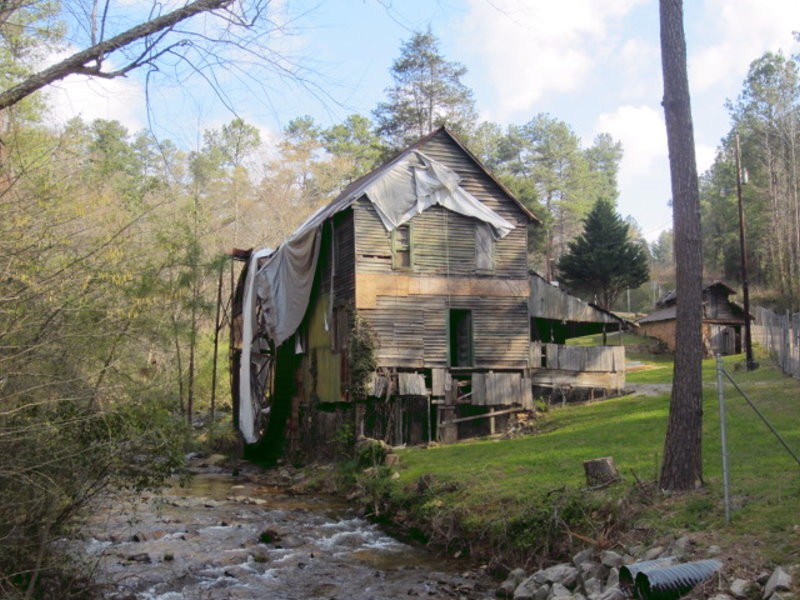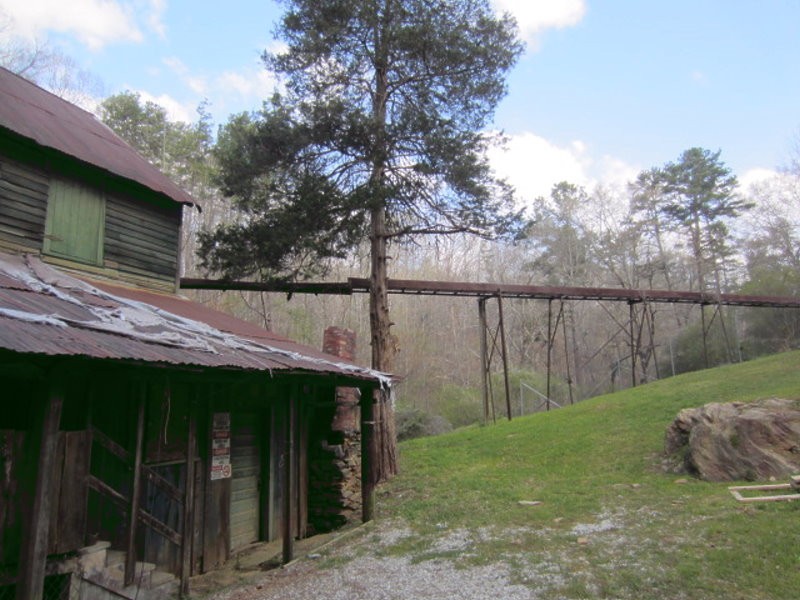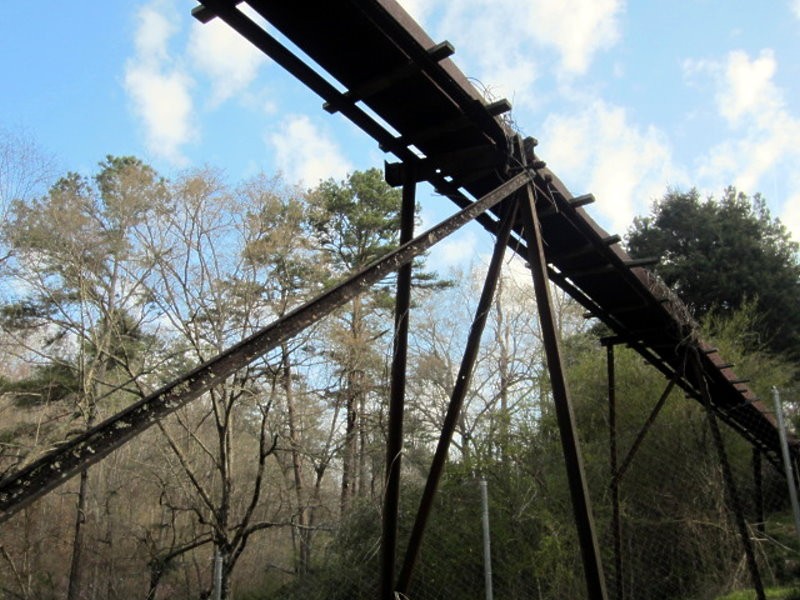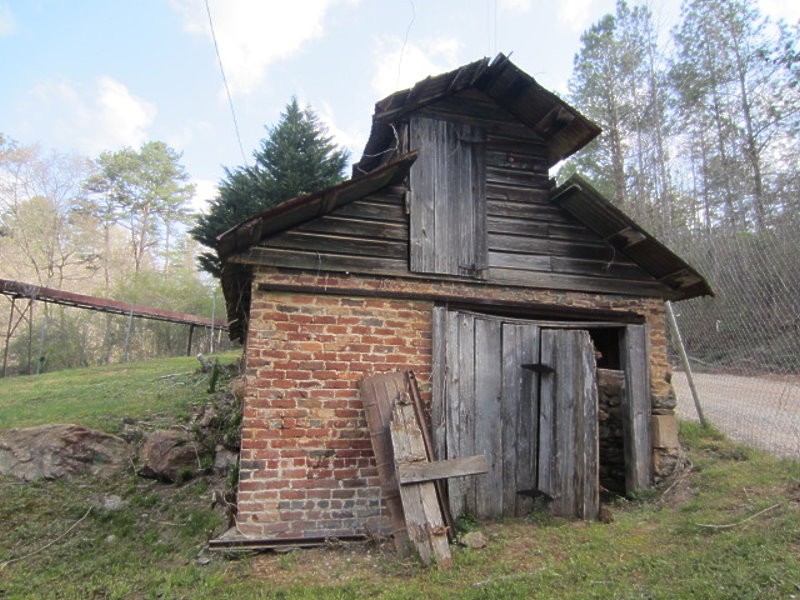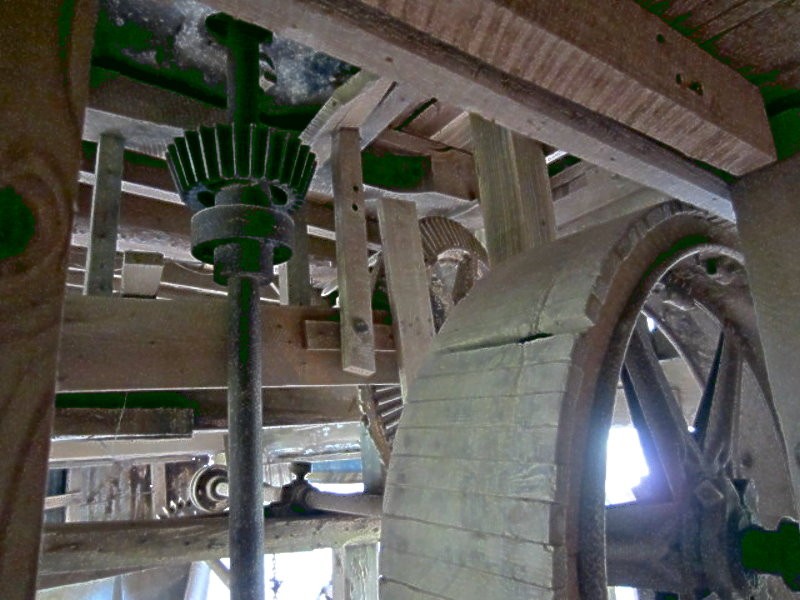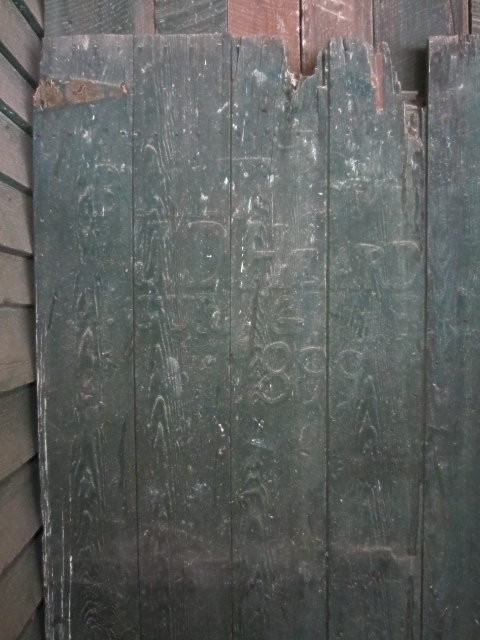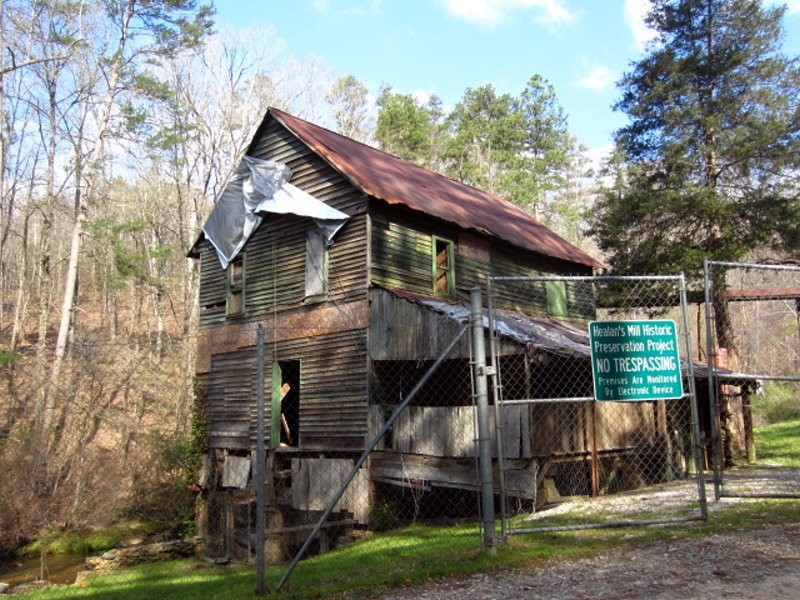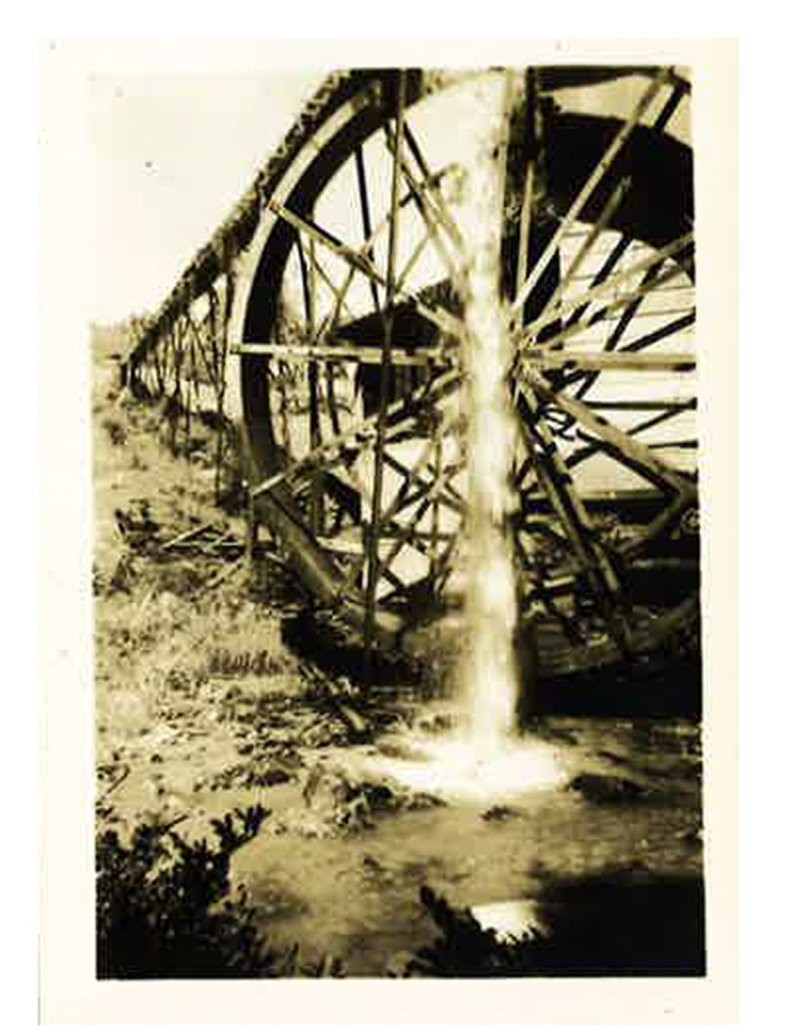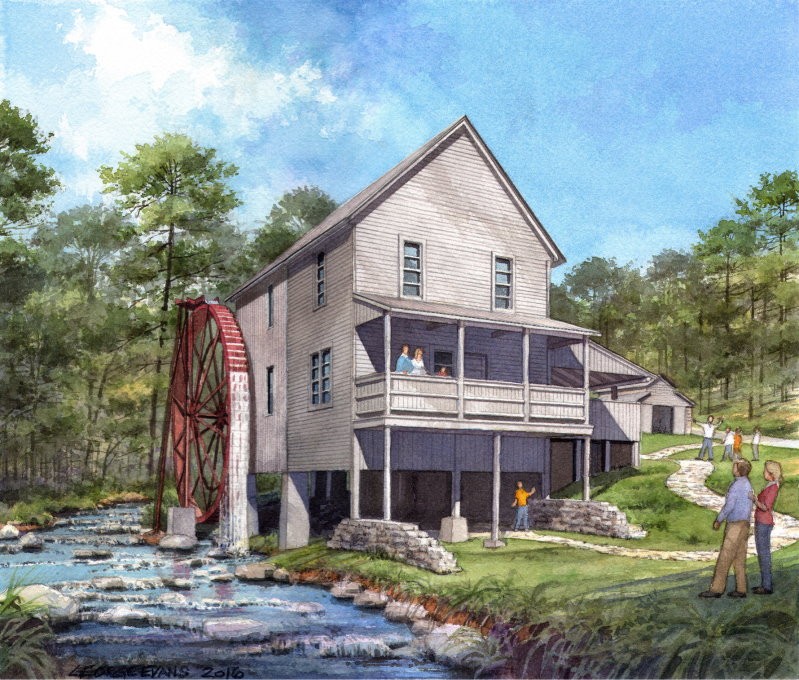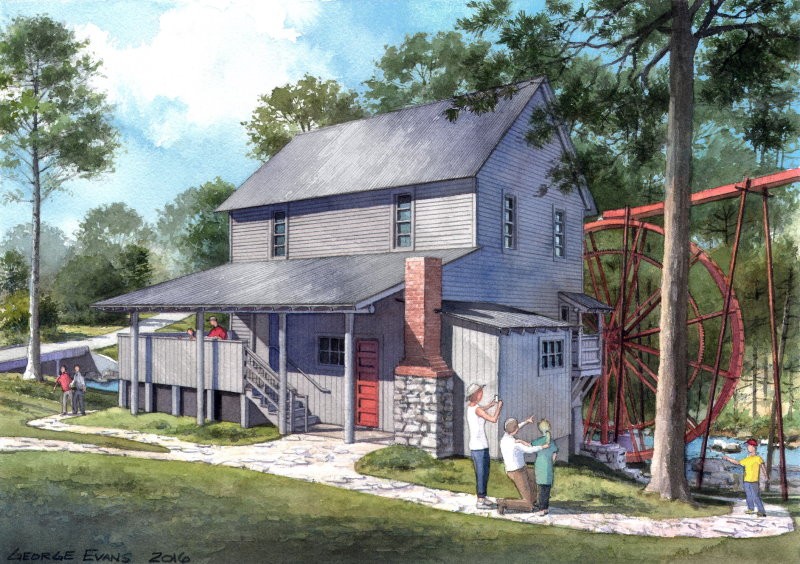Once upon a time, in the eastern part of Hall County, there was a blogger who re-realized that if she just got in her station wagon and drove far enough, she'd find something magical. For example, a 100+ year old grist mill in the midst of a Cinderella story.
Healan's-Head's Grist Mill itself, even in its current state, looks like a story book illustration come to life. Tucked away on the North Oconee River near Lula, the mill is a wooden structure, two stories tall, with a large metal wheel, followed by a metal chute that leads far out past the fence that currently encloses the structure from wanderers.
The mill was built in the early 1850's by William Head. It started as a grist – flour – mill, but served in several other capacities throughout it's 100 years in operation. Ol' Billy Head was just one of several owners of the mill – J.D. Heard, F.H. Turner, and of course, Fred and Bernice Healan. Turner was the one who replaced the wooden wheel with a metal one in the 1930's – a photo of the new wheel is the earliest known picture of the mill. After it closed, it was purchased by the Healan's in the late 1960's and used as a retreat. Around 2003, the mill and four acres of land on the Oconee River was bought up by Hall County.
"The mill was in pretty bad shape back then," said Marty Nix, who is the county's expert on the restoration project. "We stabilized it some back in the early 2000's. Hall County purchased it with Green Space money from a grant and a committee was formed... a land management agreement was signed by Hall County and that trust to basically restore the mill."
But, the recession hit like a glass slipper on a marble floor, leaving little space for the mill's restoration. "They did some work to restore the mill, however the committee became basically inactive."
Along came the special purpose local option sales tax, approved by voters like you and me in March 2015. "In SPLOST 7, this project was put on the ballot and we're going to try to stabilize the mill using SPLOST 7 funds," said Nix. "And, the committee has been reformed. Basically, we're working with them and creating a four phase plan to restore the mill, get the mill operational, create a visitors center and acquire more land around the area so we can make this not only a tourist attraction but a heritage center."
That committee is playing fairy godmother to the mill, but with blue prints, plans and drawings instead of magic wands (if only it was that simple!) The committee includes community members like Jane Hemmer, Abit Massey, Jim Syfan and Lee Hemmer, and architect Garland Reynolds, who I had the pleasure of meeting at the mill this week. Aside from being a committee member, his civil engineering firm is working with the county on the restoration plans and he has fond memories of playing near the mill as a child. He gave me the full tour.
Reynolds told me the mill has its fair share of legends - for starters, the Head family hid their gold and silver in a hollowed log under the mill wheel during the Civil War.
He also told me a Confederate soldier serving out of Virginia, Armour Rucker, walked the length of the river to the mill back to Georgia after the Civil War ended. Rucker stopped at the mill for the night and in turn, fell in love with Nancy Head, Billy's daughter.
And, Bill Miner, the gentleman bandit and supposed originator of the phrase "Hands Up," also made an appearance at the mill, supposedly hiding gold he stole from a train at Browning's Crossing in the hills around the mill. Of course, that treasure has never been found.
Aside from the legends, Reynolds told me so many things about the mill, how it's supposed to work, about original structures, details and brick work, original beams, names carved in to doors... truly the definition of awesome.
The restoration will follow the first known photo of the mill - circa the 1930's - and will start with the exterior.
The porch will be removed and rebuilt, including a new, handicap-accessible entrance. A warming room near the entrance will be updated, too, adding a more scenic view. "There's nothing there, so I'm opening that up with glass doors and a railing, so it will be like a balcony so you can go out and look over," Reynolds said. Upstairs, the mill grinder will get a new balcony. And, metal siding will be put on the back of the mill to prevent wood rot from the river.
As for the wheel, Reynolds explained it's turned by the weight of the water and not by the force - each pan on metal wheel holds about 80 pounds of water. About 12 pans are full at one time, meaning it generates up to 11 horsepower. A new shutter will be put on the wheel - "It acts sort of like a throttle, you can control home much water hit the wheel and how much will just be dumped over." A balcony next to the wheel where the miller would oil the mechanism to keep it going will also be replaced.
The mill is getting a new roof, of corrugated steel that rusts on it own to match the style. The siding will be replaced and stained to match the original siding, before it was painted the blue or green that has mostly faded away now.
"The big thing that I feel is being a great illustration of water power in early America. Electricity did not come in to this part of Hall County until just before the second World War. So the only power they had was a one cylinder diesel, some gasoline, but that was almost too expensive. So water power was the way to go."
"I think people now, particularly school children, it would be a good thing for them to learn the importance of water power - then and now."
The four stages to restoration are going to be a long journey. "When we get it structurally sound, the exterior waterproofed, and looking like it did in the 1930's, then and only then will we re-do the interior," Reynolds said. "We're not trying to make it occupiable right now. Or the operation of the wheel or the mill, that's later."
If you couldn't tell, the mill is currently closed to visitors, and fenced off, while the restoration effort continues. But if you'd like to see it from a slight distance and maybe take a few Instagram-worthy shots, head down 365 and turn on to Whitehall Road. It's down the gravel road. You'll know when you see it, because you'll feel like you just drove in to a Disney movie.
The magic for the Healan's-Head's Mill is just beginning. Since I am a supporter of historic preservation, I'll be keeping my eye on the restoration process, which will give me the opportunity to provide y'all with some updates.
But next week, I've got a little photo project to share with you. It's a bit of a detour so I'll give you a hint: I tend to be inspired most when I can't sleep. And lately, I haven't been sleeping.
Until then, stay curious.
In case you didn't read the above post at all, the mill is a work in progress and is not safe for visitors yet. Keep your exploring to photographs, please!


